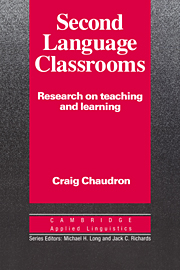Book contents
- Frontmatter
- Contents
- List of tables and figures
- Series editors' preface
- Preface
- 1 Major issues in second language classroom research
- 2 Classroom research methods
- 3 Teacher talk in second language classrooms
- 4 Learner behavior in second language classrooms
- 5 Teacher and student interaction in second language classrooms
- 6 Learning outcomes
- 7 Directions for research and teaching
- References
- Index
3 - Teacher talk in second language classrooms
Published online by Cambridge University Press: 05 October 2012
- Frontmatter
- Contents
- List of tables and figures
- Series editors' preface
- Preface
- 1 Major issues in second language classroom research
- 2 Classroom research methods
- 3 Teacher talk in second language classrooms
- 4 Learner behavior in second language classrooms
- 5 Teacher and student interaction in second language classrooms
- 6 Learning outcomes
- 7 Directions for research and teaching
- References
- Index
Summary
This chapter reviews research that has investigated second language classrooms in terms of teachers' language use in the classroom, especially the characteristic features that differentiate speech to nonnative speakers from that to native speakers. It will be seen that teacher speech displays a variety of structural modifications depending on the nature of the task and the competence of the student or listener. As was pointed out in Chapter 1, these may be important modifications, to the extent that they would enhance learners' comprehension and consequent ability to process the TL grammar and lexis. Research on the effects for learners will be addressed in Chapter 6.
In addition to studies of teachers' modifications, the general nature of teacher speech in classrooms is explored, especially phenomena which could influence the opportunities that learners have to participate or to assimilate instructional content. In particular, this discussion considers 1) the amount of teacher talk as compared with student speech in classrooms, 2) the distribution of teacher talk in terms of pedagogical and functional moves or acts, and 3) the nature of teachers' explanations. Other teacher acts which are more interactive, that is, functionally related to the preceding and following student behaviors (questions, feedback), will be discussed in Chapter 5.
Amount and types of teacher talk
Research in first language classrooms has established that teachers tend to do most of the talking (about 60% of the moves), mostly as soliciting and reacting moves (cf. Bellack et al. 1966 and Dunkin and Biddle 1974).
Information
- Type
- Chapter
- Information
- Second Language ClassroomsResearch on Teaching and Learning, pp. 50 - 89Publisher: Cambridge University PressPrint publication year: 1988
Accessibility standard: Unknown
- 6
- Cited by
